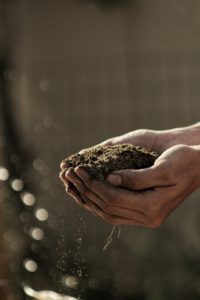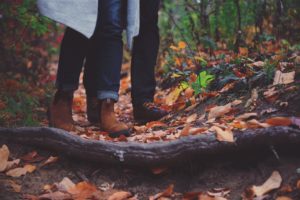My partner and I have hired a permaculture group called the Resilience Hub out of Portland, Maine, to collaborate with us in the development of a 30-year plan for our 26 acres.
Permaculture, for those of you who didn’t follow the above link, is “the development of agricultural ecosystems intended to be sustainable and self-sufficient.” In other words, it’s a holistic management plan that includes plants, animals (insects, birds and reptiles), people, water and land. The land we live on consists of wetland, a river, a pond, a year-round daylight spring, streams, fields and woodland.
That’s what we tell people, anyway. I’m beginning to understand what permaculture really means to me, though, is a commitment to love.
I’m interested to discover I’ve achieved the ripe old age of 53 and discarded nearly my entire definition of love after two marriages, two long-term non-marriage relationships and raising two children. At this point I know a lot more about what love isn’t than what it is.
Here’s my current working definition: A relationship revolving around what we want others to be is not love. A relationship revolving around the question “Who are you?” is love. Notice sex is not part of the definition. I’m talking about love in the wide sense here, the act of loving another human being, independent of legal or blood ties. For me, this is also the root of self-love. Do we endlessly tell ourselves what we should, must, and have a responsibility to be, or do we allow ourselves to discover who we in fact are?
Creating a permaculture plan for this piece of land is a deliberate and intentional journey into what the land and the life it sustains is, as well as what we are as individuals and as partners. From our most private thoughts and beliefs to the boundary of the 26 acres we live on, we become note takers and observers. We practice surrender and acceptance. We listen and watch with curiosity and attention. We are present every day with ourselves, one another, and the land. We don’t think about imposing our will. We think about collaboration and cooperation, weaknesses and strengths, effectiveness and healing.
The consent to see and be seen is a profound and intimate expression of love rippling from the inside outward. We are not intruders here. We inhabit this land and want to protect and preserve it. The porcupine living in the barn cellar, the owls down by the river, the phoebes nesting in the barn, the passing bear who wiped out our suet feeder, are not intruders, either. The poison ivy, stinging nettle, ticks and mosquitos live here. The snapping turtles in the river and the leeches in the pond call this place home, just as we do. Permaculture is a peace treaty, the practice of appreciation for the variety and complexity of life around us, and the humility to admit much of its elegant mystery is beyond our knowledge or understanding.
As I walk these acres, alone, with my partner or in a group with the Resilience Hub, I’m learning the land as I would learn a beloved’s body. I’m noticing the animal trails wandering from field to forest to river, lines and wrinkles of use tracing their way along the land’s contours and folds, suggesting where we, too, might make a path, a place to pause, a spiritual resting place.
I map old stone walls like the delicate sculpture of a spine, huge mossy boulders and landmark trees, learning the texture and landscape of this place. I wander in the thin-skinned places where old bones of ancient glacial esker are revealed. I think about bird nesting boxes, bee and pollinator boxes and honeybee hives.
Over the years, my partner has discovered all the delicate veins of water, daylight and underground, seasonal and year round, the lifeblood of the land. Thick forest hides damp, humid hollows and shallow bowls where mosquitoes fill the leaf-dappled air and the turkey and grouse hide. The grassy hair on the open slopes and fields is twined, in this season, with black-eyed Susan, purple vetch, queen Anne’s lace, wild pinks, blooming milkweed, and red clover.
The land shows us where wildflowers thrive, and which type decorate which season. It demonstrates where water runs, so we know exactly where to position a well. The trees inform us of water availability, drought, crowding, disease and age. The raptors flying over us, hunting, help us know where raptor roosts would be welcome in order to protect the woody agriculture we think of introducing against rodent damage.
As we wander this terrain, we look for nothing and try to see everything. This is how the sun falls during each month of the year. This is where the field floods when the river ice dams thaw in the spring. This is where the doe that was hit on the road lay down and died. This is the special spot where I come, early in the morning, to sit by the river and be alive. This is where the wind strokes the exposed slope, and this is where the trees shelter a small clearing that catches the sun. This is the place where a bittern pounced like a cat on some small rodent by the pond one morning. Here the snow drifts, and here it lies late in the season as the bluets bloom in the boggy field. Here was the old fox den.
Trees topple, decay into humus where fungus thrives and new trees reach for the sun. The land stretches, sheds, sloughs away and reconfigures. Species populations rise and fall. We aspire to that resilience and sustainability. We aspire to the harmony and complexity innate in the landscape around us. We don’t want more than we need to eat, to live, to love. We don’t want to be well-groomed, civilized, obedient and sterilized. We want to root the rest of our lives in the color and scent and texture of the primordial wisdom of life and death as naturally and unapologetically as the raven, the fern or the tree.
Who am I? Who is my partner? What is this land? I believe these are questions that open the way to true love; to sustainability; to reciprocity, respect and surrender. As long as we ask and cherish these questions and receive and cherish the answers, hour by hour, day by day, season by season, cycle by cycle, love endures.
All content on this site ©2017
Jennifer Rose
except where otherwise noted
© 2017 – 2021, Jenny Rose. All rights reserved.


Hi!
So happy to hear about the Permaculture group coming out to your place!
Still dreaming of this myself, just not so far North. Perhaps West of where I am now.
Your description of love is so pure. I love it.
Blessings to All of you on the 26 acres!
Margie
Thanks, Margie!
Made me cry…. I haven’t lived in the city but a short month and most mornings I wake up crying…. But determined to face my destiny… If that means anything lol…I see beautiful trees and flowers among the streets, cars, clinics, noise….. But then I have a day like yesterday at the university with students and all is well again with my soul….I content myself with knowing that I am sowing beautiful souls while my friends sow the earth we thrive on…..thank you ……mush
We all have something to give. Mine is here, now, and yours is there, now. It’s all important. Love to you. Jenny